-
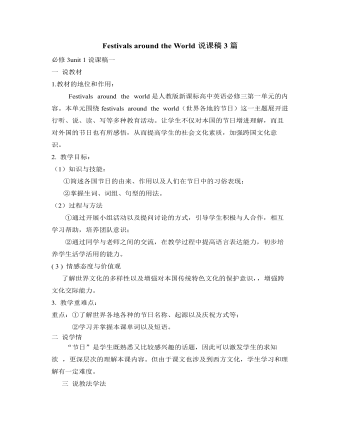
人教版高中英语必修3Festivals around the World说课稿3篇
Teaching plan for Unit 1 book3Good morning, teachers. It’s my great pleasure to be here because I can share my lesson with you and I can learn a lot from it. I’ll begin my lesson from the following four parts, the teaching material, the teaching methods, the studying methods and the teaching procedure.Firstly, let me talk about the teaching material. The content of my lesson is the reading passage festivals and celebrations of Unit 1 Festivals around the world. This passage is about festivals and celebrations. By studying this passage, we’ll enable the students to know that festivals exit everywhere, and many of festivals in different countries celebrate similar ideas. As we all know, the reading passage is the center of each unit. If the Ss can learn it well, it will be helpful to make the Ss learn the rest of this unit.After studying the teaching material, I think the teaching aims are as the followings:1. Knowledge aims:(1) The Ss can master the usage of the important words andexpressions.(2)The Ss can use the __________________ (grammar) in the proper situation.Make students know about the festivals all over the world and the detail of the festivals, such as origin, content, and the date of the holiday festivals.2. Ability aims:(1) Students can talk about festivals and celebrations in English(2) To improve the student’s reading ability, especially their skimming and scanning ability.3. Emotion aims:Make the Ss know about the foreign festivals, and respect other countries’ custom.Next, let’s come to the important points and the difficult points.The important point is how to make the Ss understand the text better and the difficult point is how can they talk about it. secondly, Teaching Methods:1. task-based Language Teaching2. Computer assisted language teaching.3. question-and–answer methodThirdly, Studying Methods:
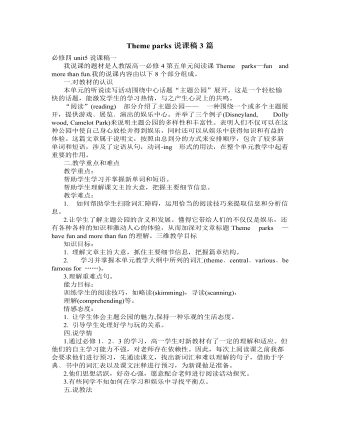
人教版高中英语必修4Theme parks说课稿3篇
The oldest and the most popular park in the worldenjoy the exciting activities thereget close to the life-size cartoon characters like Mickey Mouse and Donald Duck Step 3 Pre-reading1.What do you suppose a theme park is ?2.What do you think you can see in a theme park?(1.It is a kind of amusement park which has a certain theme – that the whole park is based on. 2.buildings, castles, statues, rare animals and birds, and so on.) Step 4 Reading ----- Theme Parks –---- Fun and More Than Fun1.Predict : Read the title and the pictures on P. 34 and PredictWhat is the meaning of the title “Theme Park – Fun and more than fun”?(The title means that theme parks are fun to visit, but that they can also be educational and can offer useful information.)2.Skimming Fast read and answer:What activities can we take in a theme park?Amusement park: Bumper car Merry-go-round slide bungee jumping Free-fall rides Horror films Pirate ship Ferris wheel roller coaster3.Scanning Read again and you will find various theme parks are mentioned in the passage . Then what are they ?Theme parks: Sports theme park History theme park Culture theme park Marine or Ocean theme Park Future park Science theme park Disneyland4.Careful reading and find the main idea of each paragraph:THEME PARKS---- entertaining/ educationalPara.1 Traditional parks are places to go for relaxation and to have time away from our busy lives.Para.2 Theme parks are different They’re large and full of things to do, see and buy.Para.3 Theme parks are built around a single idea or theme. One example is a sports park.Para.4 Another kind of theme park is historical more and cultural and can be educational.Para.5 Disneylandwas the first theme park. It is based on the fantasy life and characters of Disney’s films.Para.6 Some examples of educational theme parks include sea world parks and science parks.
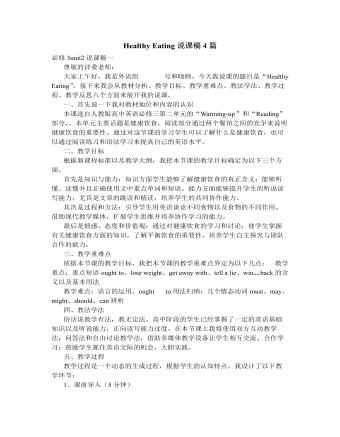
人教版高中英语必修3Healthy Eating说课稿4篇
Language learning needs a context, which can help the learners to understand the language and then can product comprehensible output, so computer has the advantages to make the materials attractive.Part 3 Learning MethodsTask-based, self-dependent and cooperative learningPart 4 Teaching ProcedureStep One Lead-in“Interest is the best teacher.” Therefore, at the very beginning of the class, I should spark the students’ mind to focus on the centre topic “the band”. I’ll show some pictures of food to attract their attention and then bring some questions.Question:What kind of food they like?What should go into a good meal?The answers must relate to the diet. After this, the students will be eager to know something about a balance diet and this is the very time to naturally lead the class into Step 2Step 2 Reading for information: skimming and scanning In this step, I use Task-based Language Teaching method, which can give students a clear and specific purpose while skimming and scanning the context.Task 1 General ideaThe students will be asked to just glance at the title and the pictures of the passage, and then guess what they will read in the text. And they’ll be divided into groups of four to have a discussion.The purpose is to inspire the students to read actively, not passively. In addition, the task is to develop the students’ reading skill by making prediction and to encourage the students to express their thoughts in English and cooperate with each other.Task 2 Main idea of each paragraphCooperative learning can raise the students’ interest and create an atmosphere of achievement. Based on this theory, I divide the whole class into 4 groups to skim the whole text and get the main idea of each paragraph.
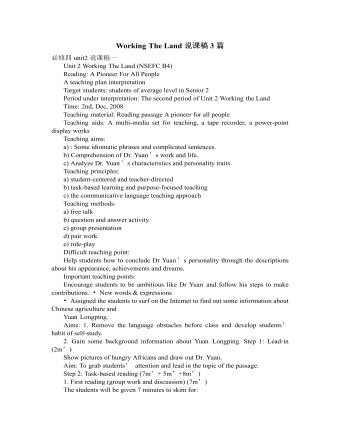
人教版高中英语必修4Working The Land说课稿3篇
Knowledge objectives:(1) to make Ss grasp the usage of words, expressions and sentence structures: statistics, struggle, thanks to, rid of, some patterns for persuasion, the “ing” form as subject and object;(2)to use learnt knowledge to persuade sb.Ability objectives:(1) to develop Ss’ reading skills(skimming, scanning, word guessing);(2) to improve Ss’ speaking, communicating and cooperating skills.Emotional objectives:to make Ss know the contribution of Yuan,and learn his spirit and his simple life time.Teaching important and difficult points:(1) some words, expressions and sentence structures mentioned above;(2)the content of the text;(3)training their reading and speaking skills.Teaching methods: CLT, TBLT,QT.Learning strategies: CLS, QLS, TBLS.Teaching procedures:Step 1 lead-in: (1) teacher plays a piece of recent news from CCTV about the harvest of the super hybrid rice, and ask students whether they know Yuan or not, and talk about him and his contribution.(2)Brain storm: let Ss describe Yuan in their minds including his appearance, his living condition and so on.Step 2 fast reading tasks:(1)teacher introduces Yuan and super hybrid rice(2)make Ss read the text as fast as possible with questions. Such as: what’s the general ideaof this passage? What’s Yuan’ dream? (skimming and scanning skill)Step 3 intensive reading tasks(1)let Ss read the text silently, find topic sentence of each paragraph and draw the difficult sentences and the knowledge what they don’t understand.(words guessing)(2)teacher and Ss talk about the important words, expressions and sentences together, and ask Ss to retell the content of the text.(summarizing and paraphrasing)(3)teacher summarize this part.(4) read again following the courseware.
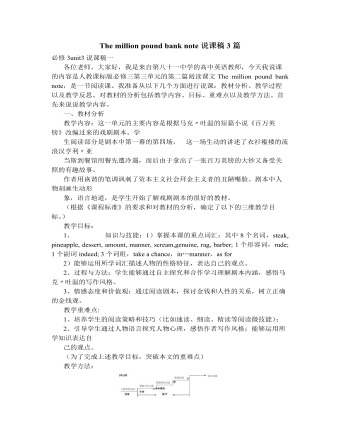
人教版高中英语必修3The million pound bank note说课稿3篇
在接下来的细读环节,我套用了高考对阅读理解的考查方式设置了5个问题,分别为三个推理判断题,一个细节题和一个主旨大意题。学生需要对文章的内容进行分析、归纳、推理、猜测等高级思维活动才能做出正确的回答。【设计意图】这一过程是对学生进行细读的训练,培养学生获取特定信息和挖掘文章深层次信息的能力。第三环节:Intensive-reading (精读) 15′第三个环节精读,既是最重要的环节,也是突破本课重难点的关键。首先,让学生思考剧本中人物看到百万英镑前后的态度发生了怎样的变化。其次,让学生仔细阅读文章,找出可以表现人物态度变化的具体的语言和动作。最后,让学生总结人物的态度发生变化的根本原因是什么,从而引出Money Talks, 供学生思考。【设计意图】通过一系列的活动培养学生学习从人物的语言和动作探究人物的心理,使学生进一步体会戏剧语言的魅力,从而对文章背后所反映的社会问题进行思考,也为下一步的讨论环节做好铺垫。
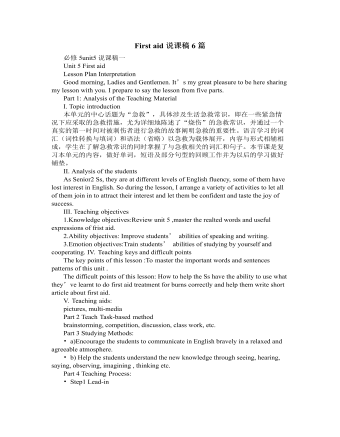
人教版高中英语必修5First aid说课稿6篇
In this class, I have 3 teaching aims, that is, knowledge aims, ability aims and emotion aims.1) Knowledge-Teach students new words and expressions, such as temporary, bleed,sprain choke, first aid, fall ill and so on.-Enable students to have a better understanding for some basic knowledge of first aid.2) Ability-Train students’ speaking, reading and writing abilities by different teaching activities, such as skimming, comprehending, team work, role play, retelling and writing.-Develop students’ reading strategy on how to move general idea to specific information.3) Emotion-Promote students’ awareness of giving first aid.- Cultivate students’ creativities.Then let’s come to my teaching methods and activities.III. Teaching methods and activities:To achieve different teaching aims, various kinds of teaching methods and activities will be adopted throughout this period, such as TBL (task-based learning), skimming, team work, brainstorm and others, which can offer students opportunities to fulfill tasks in which they can use language to achieve a specific outcome.IV. Teaching aids:Computer and blackboardV. Teaching important points:1) Make students have a clear mind for the structure of the text.2) Help students understand the theme of the text.VI. Teaching difficulties:1) So many new words may affect students’ understanding.2) How to get students to know about the functions of the skin and thecauses, characteristics and treatments for different degree burns,and the knowledge about giving first aid. VII. Blackboard design:
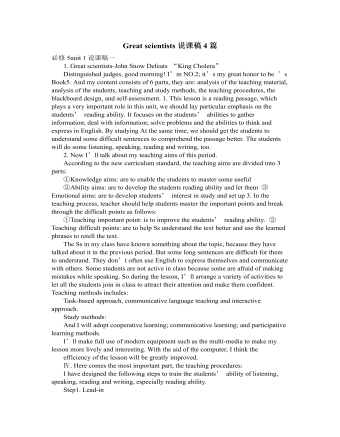
人教版高中英语必修5Great scientists说课稿4篇
通过写文章梗概,培养学生综合运用语言的能力,学习用恰当的英语描述科学家的故事。这是本课的教学难点。教师可以使用完形填空的方式来帮助学生整理语篇,从而来降低难度。本课的教学重点的突破方法是:在阅读前,让学生初步了解得出科学观点所需要的基本程序,从而轻松而自然地导入文章的阅读;在阅读过程中,由易到难设计快速阅读和精读的问题,层层推进各种阅读活动,让学生对阅读内容从整体感知到细节理解,最后深层读懂整篇文章,同时加强阅读策略的指导,让每个学生都主动参与课堂教学活动,最终达到提高阅读能力的目的。Step 4 Post-readingGroup Activities四人小组共同合作,在老师的适当指导下,就以下2个问题展开讨论,让学生就所知、所学、所感和所想融入话题,然后抽若干同学代表作小组发言。1. What do you think about John Snow, and what should we learn from him?2. Cholera was 19th century disease, which two diseases are similar to cholera today? Why?
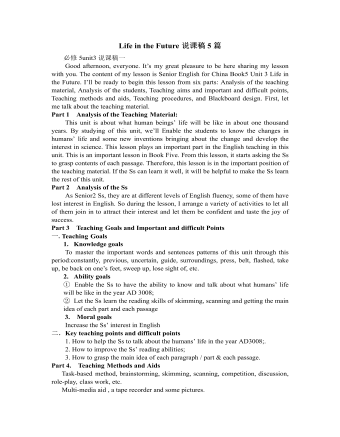
人教版高中英语必修5Life in the Future说课稿5篇
Good afternoon, everyone. It’s my great pleasure to be here sharing my lesson with you. The content of my lesson is Senior English for China Book5 Unit 3 Life in the Future. I’ll be ready to begin this lesson from six parts: Analysis of the teaching material, Analysis of the students, Teaching aims and important and difficult points, Teaching methods and aids, Teaching procedures, and Blackboard design. First, let me talk about the teaching material.Part 1 Analysis of the Teaching Material:This unit is about what human beings’ life will be like in about one thousand years. By studying of this unit, we’ll Enable the students to know the changes in humans’ life and some new inventions bringing about the change and develop the interest in science. This lesson plays an important part in the English teaching in this unit. This is an important lesson in Book Five. From this lesson, it starts asking the Ss to grasp contents of each passage. Therefore, this lesson is in the important position of the teaching material. If the Ss can learn it well, it will be helpful to make the Ss learn the rest of this unit.Part 2 Analysis of the SsAs Senior2 Ss, they are at different levels of English fluency, some of them have lost interest in English. So during the lesson, I arrange a variety of activities to let all of them join in to attract their interest and let them be confident and taste the joy of success.
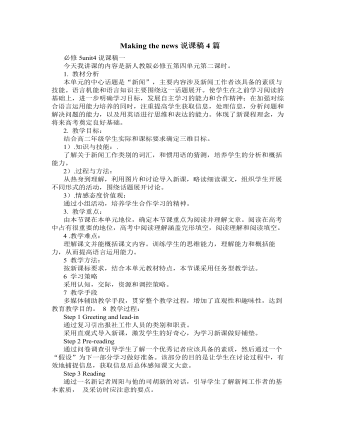
人教版高中英语必修5Making the news说课稿4篇
今天我们来介绍一下必修五第四单元的授课方式。这个单元的题目是Making the news。应该是学生比较感兴趣的话题,学生往往对新闻工作充满好奇,所以我们可以利用这个机会多设计一些师生互动和学生互动,来激发起学习的积极性,提高学习效率。同时我们可以利用这个单元不仅帮助学生掌握语言知识,培养语言能力,同时让其了解新闻工作的重要性,培养起社会智能感。这个单元分为六个课时,它的教学目标是这样的:语言目标是掌握词汇表中的常用单词和短语,掌握倒装句的一些基本用法。 技能目标是能初步掌握约会的基本句型并在真实的场景下正确运用。新闻报道类文章的写作技能。采访的基本规范和沟通技能。情感目标是对新闻报道的客观性和真实性有更好的理解。对新闻记者的职业有更深入的了解,并能体会其工作的重要性。下面我们来介绍一下第一课时的授课方式,第一课的教学目标是这样的第一课时的教学目标语言目标:单词:Occupation, journalist, editor, photographer, curious, personality, enthusiasm
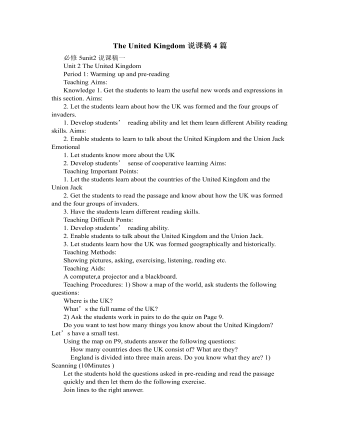
人教版高中英语必修5The United Kingdom说课稿4篇
Teaching Aims:Knowledge 1. Get the students to learn the useful new words and expressions in this section. Aims:2. Let the students learn about how the UK was formed and the four groups of invaders.1. Develop students’ reading ability and let them learn different Ability reading skills. Aims:2. Enable students to learn to talk about the United Kingdom and the Union Jack Emotional 1. Let students know more about the UK2. Develop students’ sense of cooperative learning Aims:Teaching Important Points:1. Let the students learn about the countries of the United Kingdom and the Union Jack2. Get the students to read the passage and know about how the UK was formed and the four groups of invaders.3. Have the students learn different reading skills.Teaching Difficult Ponts:1. Develop students’ reading ability.2. Enable students to talk about the United Kingdom and the Union Jack.3. Let students learn how the UK was formed geographically and historically.Teaching Methods:Showing pictures, asking, exercising, listening, reading etc.Teaching Aids:A computer,a projector and a blackboard.Teaching Procedures: 1) Show a map of the world, ask students the following questions:Where is the UK?What’s the full name of the UK?2) Ask the students work in pairs to do the quiz on Page 9.Do you want to test how many things you know about the United Kingdom? Let’s have a small test.Using the map on P9, students answer the following questions:?How many countries does the UK consist of? What are they??England is divided into three main areas. Do you know what they are? 1) Scanning (10Minutes )Let the students hold the questions asked in pre-reading and read the passagequickly and then let them do the following exercise.Join lines to the right answer.
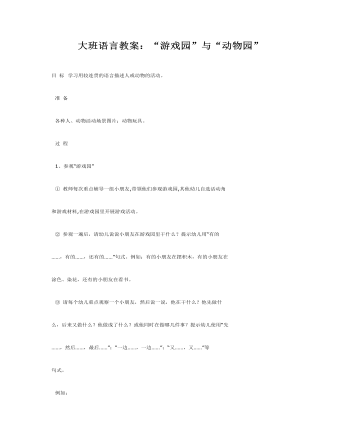
大班语言教案:“游戏园”与“动物园”
准备 各种人、动物活动场景图片;动物玩具。 过程 1、参观“游戏园” ①教师每次重点辅导一组小朋友,带领他们参观游戏园,其他幼儿自选活动角和游戏材料,在游戏园里开展游戏活动。 ②参观一遍后,请幼儿说说小朋友在游戏园里干什么?提示幼儿用“有的……,有的……,还有的……”句式。例如:有的小朋友在摆积木,有的小朋友在涂色、染花,还有的小朋友在看书。 ③请每个幼儿重点观察一个小朋友,然后说一说,他在干什么?他先做什么,后来又做什么?他做成了什么?或他同时在做哪几件事?提示幼儿使用“先……,然后……,最后……”;“一边……,一边……”;“又……,又……”等句式。 例如: “他在搭火车站,他先搭大楼(候车室),然后搭铁路和桥,最后建广场,他搭成了一个新火车站。”
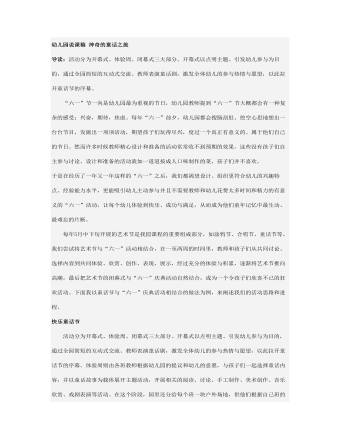
幼儿园说课稿 神奇的童话之旅
“六一”节一向是幼儿园最为重视的节日,幼儿园教师提到“六一”节大概都会有一种复杂的感受:兴奋,期待,焦虑。每年“六一”前夕,幼儿园都会搜肠刮肚、挖空心思地想出一台台节目,发掘出一项项活动,期望孩子们玩得尽兴,度过一个真正有意义的、属于他们自己的节日。然而许多时候教师精心设计和准备的活动常常收不到预期的效果。这些没有孩子们自主参与讨论、设计和准备的活动就如一道道按成人口味制作的菜,孩子们并不喜欢。于是在经历了一年又一年这样的“六一”之后,我们都渴望设计、组织更符合幼儿的兴趣特点、经验能力水平,更能吸引幼儿主动参与并且不需要教师和幼儿花费太多时间和精力的有意义的“六一”活动,让每个幼儿体验到快乐、成功与满足,从而成为他们童年记忆中最生动、最难忘的片断。
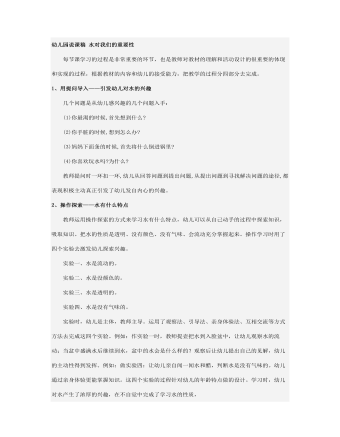
幼儿园说课稿 水对我们的重要性
教师运用操作探索的方式来学习水有什么特点,幼儿可以从自己动手的过程中探索知识,吸取知识。把水的性质是透明、没有颜色、没有气味、会流动充分掌握起来。操作学习时用了四个实验去激发幼儿探索兴趣。 实验一、水是流动的。 实验二、水是没颜色的。 实验三、水是透明的。 实验四、水是没有气味的。 实验时,幼儿是主体,教师主导。运用了观察法、引导法、亲身体验法、互相交流等方式方法去完成这四个实验。例如:作实验一时,教师提壶把水到入脸盆中,让幼儿观察水的流动;当盆中盛满水后继续到水,盆中的水会是什么样的?观察后让幼儿提出自己的见解,幼儿的主动性得到发挥。例如:做实验四:让幼儿亲自闻一闻水和醋,判断水是没有气味的。幼儿通过亲身体验更能掌握知识。这四个实验的过程针对幼儿的年龄特点做的设计。学习时,幼儿对水产生了浓厚的兴趣,在不自觉中完成了学习水的性质。
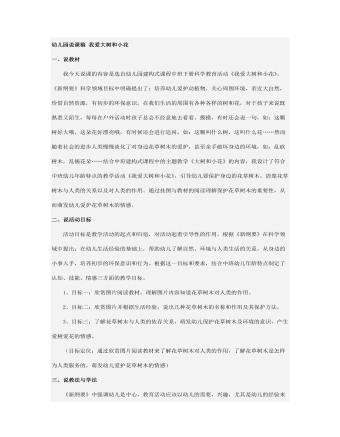
幼儿园说课稿 我爱大树和小花
我今天说课的内容是选自幼儿园建构式课程中班下册科学教育活动《我爱大树和小花》。《新纲要》科学领域目标中明确提出了:培养幼儿爱护动植物,关心周围环境,亲近大自然,珍惜自然资源,有初步的环保意识。在我们生活的周围有各种各样的树和花,对于孩子来说既熟悉又陌生,每每在户外活动时孩子总会不经意地去看看、摸摸,有时还会说一句,如:这颗树好大哦,这朵花好漂亮哦,有时候还会进行追问,如:这颗叫什么树,这叫什么花……然而随着社会的进步人类慢慢淡化了对身边花草树木的爱护,甚至亲手破坏身边的环境,如:乱砍树木,乱摘花朵……结合中班建构式课程中的主题教学《大树和小花》的内容,我设计了符合中班幼儿年龄特点的教学活动《我爱大树和小花》,引导幼儿要保护身边的花草树木,清楚花草树木与人类的关系以及对人类的作用。通过挂图与教材的阅读理解保护花草树木的重要性,从而萌发幼儿爱护花草树木的情感。
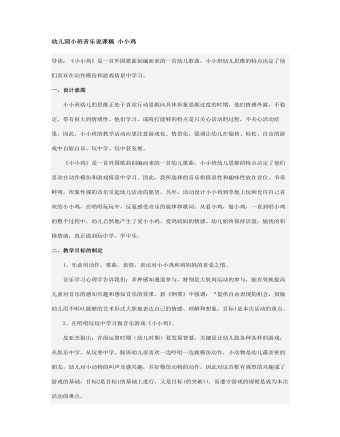
幼儿园小班音乐说课稿 小小鸡
小小班幼儿的思维正处于直觉行动思维向具体形象思维过度的时期,他们情感外露,不稳定,带有很大的情绪性。他们学习、或殴打能够的特点是只关心活动的过程,不关心活动结果,因此,小小班的教学活动应更注意游戏化、情景化,强调让幼儿在愉快、轻松、自由的游戏中自娱自乐、玩中学、玩中获发展。 《小小鸡》是一首外国歌曲创编而来的一首幼儿歌曲,小小班幼儿思维的特点决定了他们喜欢在动作模仿和游戏情景中学习。因此,我所选择的音乐将情景性和趣味性放在首位,节奏鲜明,形象性强的音乐引起幼儿活动的愿望,另外,活动设计小小鸡到草地上玩和允许自己喜欢的小小鸡,在唱唱玩玩中,反复感受音乐的旋律和歌词。从看小鸡,做小鸡,一直到唱小鸡的整个过程中,幼儿自然地产生了爱小小鸡、爱鸡妈妈的情感。幼儿始终保持活泼,愉快的积极情绪,真正做到玩中学,学中乐。
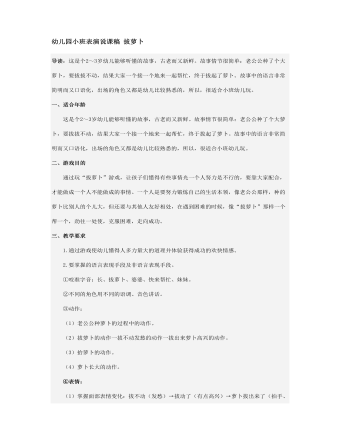
幼儿园小班表演说课稿 拔萝卜
1、让孩子们熟悉故事? 一听:听家长和老师讲,也可以听录音带,有些地方可反复讲、放。 二讲:让孩子们复述故事。 三熟悉:先让孩子们一起一段一段地把故事讲完整,然后以个人或角色小组为单位,配合讲出完整的故事。? 2、示范表演 老师先扮老公公,然后再扮老婆婆,这样一一地把角色的动作和语言给孩子们示范一遍,示范时要注意紧紧抓住各角色的典型特征,如老公公走路和小弟弟、小花狗走路就不一样,但动作应宁简勿繁,以利孩子模仿。 3、自由试演 让小朋友们自由搭配成小组,自由尝试表演各种角色,家长或老师在鼓励的同时作适当的指点。 表演的要点有:各角色动作的典型特征,说话的声音特征,想拔出萝卜的渴望,拔不出萝卜的焦急,盼望帮助的急切和帮忙者的热情,拔出萝卜后的高兴等等。 4、观摩表演 即正式妆扮好分组表演,家长或老师以及不上场的小朋友一起观看。在观摩中可对出场次序、对话、表演等方面进行一定的提示,但应充分鼓励孩子的自由发挥。另外,在表演中加入音乐或音响效果,更能增加游戏气氛。
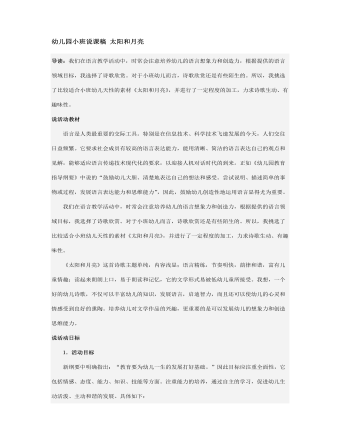
幼儿园小班说课稿 太阳和月亮
语言是人类最重要的交际工具。特别是在信息技术、科学技术飞速发展的今天,人们交往日益频繁。它要求社会成员有较高的语言表达能力,能用清晰、简洁的语言表达自己的观点和见解,能够适应语言传递技术现代化的要求,以迎接人机对话时代的到来。正如《幼儿园教育指导纲要》中说的“鼓励幼儿大胆、清楚地表达自己的想法和感受。尝试说明、描述简单的事物或过程,发展语言表达能力和思维能力”,因此,鼓励幼儿创造性地运用语言显得尤为重要。 我们在语言教学活动中,时常会注意培养幼儿的语言想象力和创造力,根据提供的语言领域目标,我选择了诗歌欣赏。对于小班幼儿而言,诗歌欣赏还是有些陌生的。所以,我挑选了比较适合小班幼儿天性的素材《太阳和月亮》,并进行了一定程度的加工,力求诗歌生动、有趣味性。 《太阳和月亮》这首诗歌主题单纯,内容浅显;语言精练,节奏明快,韵律和谐,富有儿童情趣;读起来朗朗上口,易于朗读和记忆,它的文学形式易被低幼儿童所接受。我想,一个好的幼儿诗歌,不仅可以丰富幼儿的知识,发展语言,启迪智力,而且还可以使幼儿的心灵和情感受到良好的熏陶。培养幼儿对文学作品的兴趣,更重要的是可以发展幼儿的想象力和创造思维能力。
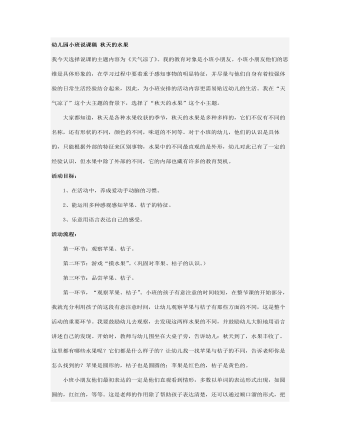
幼儿园小班说课稿 秋天的水果
我今天选择说课的主题内容为《天气凉了》。我的教育对象是小班小朋友。小班小朋友他们的思维是具体形象的,在学习过程中要着重于感知事物的明显特征,并尽量与他们自身有着较强体验的日常生活经验结合起来,因此,为小班安排的活动内容更需易贴近幼儿的生活。我在“天气凉了”这个大主题的背景下,选择了“秋天的水果”这个小主题。 大家都知道,秋天是各种水果收获的季节,秋天的水果是多种多样的,它们不仅有不同的名称,还有形状的不同,颜色的不同,味道的不同等。对于小班的幼儿,他们的认识是具体的,只能根据外部的特征来区别事物,水果中的不同最直观的是外形,幼儿对此已有了一定的经验认识,但水果中除了外部的不同,它的内部也藏有许多的教育契机。
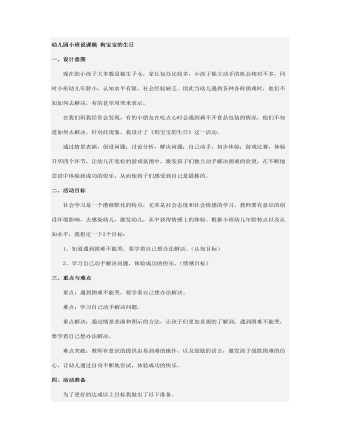
幼儿园小班说课稿 狗宝宝的生日
现在的小孩子大多数是独生子女,家长包办比较多,小孩子独立动手的机会相对不多。同时小班幼儿年龄小,认知水平有限,社会经验缺乏。因此当幼儿遇到各种各样困难时,他们不知如何去解决,有的甚至用哭来表示。 在我们班我经常会发现,有的小朋友在吃点心时会遇到剥不开食品包装的情况,他们不知道如何去解决。针对此现象,我设计了《狗宝宝的生日》这一活动。 通过情景表演,创设问题;讨论分析,解决问题;自己动手,初步体验;游戏比赛,体验升华四个环节,让幼儿在宽松的游戏氛围中,激发孩子们独立动手解决困难的欲望,在不断地尝试中体验到成功的快乐,从而使孩子们感受到自己是最棒的。
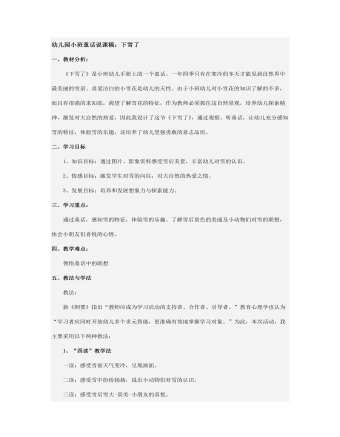
幼儿园小班童话说课稿:下雪了
1、创设情境,激趣导入 先谈话导入“小朋友们现在是什么季节,天气冷吗?”。 事先准备好“雪花”(泡沫削)放在有缝隙的篮子里,篮子放在空调吹风出,打开空调,雪花从天而降,“小朋友们快看,天上飘落了什么?”幼儿一定会兴奋地说道下雪了。“你们喜欢下雪吗?接着播放《雪绒花》音乐,让幼儿回忆下雪时的情景,在柔美的音乐中轻柔飘舞,此时注意不能让幼儿太兴奋以免影响下面活动的发展,而因静静地带他们在座位上飞舞轻柔地使他们安静下来。2、欣赏探索 首先出示《下雪了》图片,引导幼儿欣赏图片,幼儿对新的刺激物很感兴趣,看到图片会自由的说出看到的东西,此时我把一分钟留给幼儿,让他们说说自己看到的。 讲童话部分,我决定运用“四读”法有感情的讲童话。





















